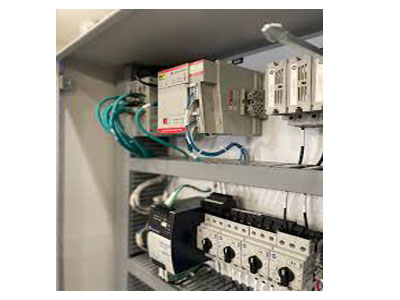How To Design A VFD Control Panel?
Key Takeaway
Designing a VFD (Variable Frequency Drive) control panel involves key steps to ensure functionality and safety. First, choose an enclosure rated for the environment, like NEMA 3R for outdoor use. This helps protect the panel from weather conditions. Next, select the right VFD based on power requirements and communication needs. Ensure the main circuit breaker matches the total current load and has a suitable short-circuit rating.
Include necessary components like line reactors, circuit breakers, a bypass switch, and cooling options if needed. Temperature control is important, so add heaters or desiccants to prevent condensation and maintain performance. Ensure the design provides clear operation and safety features like hand-off-auto control and status indicators for the VFD’s operating mode. Proper design helps protect the VFD and motor system from overloads and ensures reliable, efficient operation in various industrial settings.
Key Considerations for VFD Panel Design
Designing a VFD control panel starts with understanding the application requirements. This includes the motor specifications, load type, and operational environment. Calculate the motor’s horsepower, voltage, and frequency needs. Evaluate environmental factors such as temperature, humidity, and potential exposure to dust or corrosive elements.
Space constraints are another crucial factor. Ensure that the panel can accommodate all components without compromising functionality or safety. Ventilation is essential to manage heat generated by the VFD and other components, preventing overheating and prolonging the system’s life.
Lastly, consider future scalability. If the system may require additional drives or features later, design the panel with room for expansion. This foresight can save significant costs and effort in the long run.

Selecting the Right Components
The heart of a VFD panel lies in its components. Begin with the VFD itself, ensuring it matches the motor’s specifications and operational demands. Choose circuit breakers or fuses to protect against short circuits and overloads. Contactor relays are essential for switching operations, while isolation transformers can help reduce noise and interference.
Don’t overlook the importance of a Human-Machine Interface (HMI) or display unit, which allows operators to monitor and control the panel easily. Additionally, include cooling fans or heat sinks to manage thermal conditions effectively.
Every component should be sourced from reliable manufacturers to ensure durability and compatibility. Prioritize energy efficiency and reliability, as these aspects directly impact the system’s performance and operational costs.
Layout and Wiring Best Practices
A well-organized layout ensures the panel operates safely and efficiently. Begin by planning the placement of each component. High-voltage sections should be segregated from low-voltage control components to avoid interference.
Label all wiring clearly for easy identification during installation and maintenance. Use color-coded wires and adhere to standardized wiring diagrams. Keep wire lengths to a minimum to reduce resistance and ensure efficient signal transmission.
Cable management tools such as duct covers and cable ties help maintain a tidy layout. Ensure adequate spacing between components for ventilation and easy access during maintenance. This not only improves reliability but also simplifies troubleshooting.
Safety and Compliance Standards
Safety is paramount when designing VFD panels. Adhere to local and international electrical standards, such as IEC or NEMA regulations. Use components with proper certifications to ensure compliance.
Include safety features like emergency stop buttons, grounding systems, and surge protectors. The enclosure should be rated for the environment, such as IP ratings for dust and water resistance. Ensure proper earthing and insulation to avoid electrical hazards.
Regular inspections and risk assessments during the design process can help identify potential safety issues before they arise. This proactive approach minimizes risks and ensures a reliable system.
Testing and Validation of VFD Panels
Before commissioning, the VFD panel must undergo thorough testing. Begin with continuity checks to ensure proper connections and absence of shorts. Power up the panel without load to verify voltage and signal accuracy.
Functional testing involves running the motor under different load conditions to evaluate performance. Test safety features like overload protection, emergency stops, and alarms to ensure they operate as intended.
Documentation is equally important. Maintain detailed records of all tests, including results and adjustments made. This serves as a reference for future maintenance and troubleshooting, ensuring long-term reliability.
Conclusion
Designing a VFD control panel is a meticulous process requiring attention to detail and adherence to best practices. From selecting the right components to ensuring safety and compliance, every step plays a vital role in creating an efficient and reliable system. By following these guidelines, you can design VFD panels that optimize performance and meet industrial demands.

